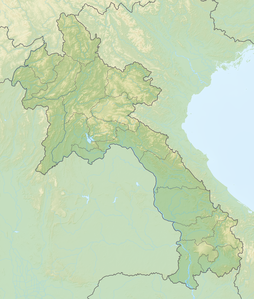Don Khong
| Don Khong | ||
|---|---|---|
| Waters | Mekong | |
| Geographical location | 14 ° 8 ′ N , 105 ° 50 ′ E | |
|
|
||
| length | 18 km | |
| width | 8 kilometers | |
| main place | Muang Khong | |
Don Khong (Eng. Khong Island ) is a river island in the Mekong in the southern Lao province of Champasak . The (depending on the water level) in north-south direction about 16-18 km long and up to 8 km wide island is located in the north of the area Si Phan Don ( four thousand islands ) and is the main island of the region. It is the largest Laotian island and around one of the largest islands in the Mekong.
The distance to the provincial capital Pakse is about 120 km; to the nearby Cambodian border in the south at Veun Kham it is about 30 km. The population is between 13,000 and 50,000 people, depending on the source. The capital of the island is Muang Khong in the east, which is also the administrative seat of the Khong district .
The northern and central part of the island consists of slightly hilly woodland, while rice is grown in the flat south and on the coasts .
Transport and infrastructure
Through the Mekong, Don Khong is connected on the river route upstream with Pakse and practically all important Laotian cities, downstream with the somewhat smaller islands Don Khon and Don Det, only a few kilometers away . The river route to Cambodia is interrupted by the Mekong Falls .
National Road 13 runs along the eastern bank of the Mekong and crosses all of Laos from the Chinese to the Cambodian border. From the town of Ban Hat Xai Khun on the road, a bridge leads to Don Khong. The bridge opened in 2014 (718 m long, 11 m wide) replaced the ferry service to the island that had existed until then.
Don Khong has airport codes ( IATA airport code : KOG ; ICAO code : VLKG ), but the airport is practically no longer used; the next regularly served airport is Pakse International Airport .
The most common modes of transport on the island are bicycles and motorbikes .
Economy and tourism
The main occupations of the population are fishing and agriculture ; most of the southern island is covered by rice fields.
In addition, tourism is playing an increasingly important role: Don Khong has the reputation of a quiet, idyllic and therefore relaxing place. The island is therefore often visited by tourists who visit the region because of the Mekong Falls and the Irrawaddy dolphins ; in addition, Don Khong also serves as a popular stopover on the way to Cambodia. Since the island has been electrified for over ten years , numerous comfortable and therefore more expensive accommodations have been created. Backpackers therefore mostly travel to the southern island of Don Det, which is considered to be simpler and cheaper, but also livelier.
Culture
Practically the entire native island population is Buddhist , on the island there are several important temples ( Wats ): In Muang Khong you can find the large and modern Wat Phouang Keo ( Wat Kan Khong ) as well as the smaller, but much older Wat Chom Thong . In the interior of the island is the cave temple Tham Phou Khiao ( Cave of the Green Mountain ). In the west of the island, north of Muang Saen, lies Wat Phou Khao Keo , which was built on the foundations of a Khmer cult site and under which, according to legend, there is an entrance to the underworld of the Nagas .
Places on the island
- Muang Khong , in the east, capital of the island
- Muang Saen Nua , in the west, second largest place
- Ban Houa Khong , in the northwest, birthplace of the former Lao President Khamtay Siphandone
- Ban Houa Khong Lem , on the northern tip
- Ban Dong , in the northeast
- Ban Naa , in the southeast near Muang Khong
- Ban Huay , on the southern tip
literature
- Andrew Burke, Justine Vaisutis: Laos, pp. 291-293
- Joshua Eliot, Jane Bickersteth: Laos Handbook, pp. 235-240
